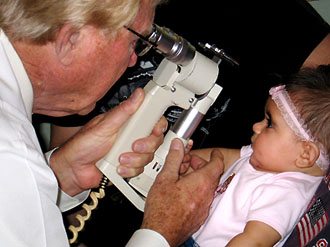Baby's Eyesight Rescued
When Alexa Feurtado visited the Tulane Ophthalmology Clinic in October for her yearly eye examination with Dr. Delmar Caldwell, she brought along her four-month-old baby, Ily. Caldwell, professor and chair of ophthalmology, has been treating Alexa since removing double cataracts when she was five months old, about 20 years ago.

Dr. Delmar Caldwell, professor and chair of ophthalmology, examines the eyes of Ily Fricano, who had congenital cataracts removed from both eyes. (Photo by Arthur Nead)
As Caldwell entered the exam room, Alexa was holding Ily (whose name is an acronym for "I love you") in her lap. "When I spoke," he says, "Ily focused her attention to my voice, and that is when I immediately noticed she had the same condition as her mother."
Congenital cataracts are uncommon, but there are a few cases reported each year, according to Caldwell, and it is extremely important to treat the condition as early as possible.
The operations, one on each of Ily's eyes, were a week apart, and the bandages were off quickly.
"Ily's lenses will likely be good for her whole life," Caldwell says, and the lenses used now are also bifocal, which gives a lot of extra power.
When Ily's mom, Alexa, had her cataracts removed, doctors did not put lenses in children because their eyes were still growing, but ophthalmology has made great strides since then. "Now, doctors implant lenses in children that are projected to have the right shape and size when they will be about 17 years of age, and the eyes have stopped growing," Caldwell says.
Ily's father, Frank Fricano Jr., says, "Now Ily focuses a lot more. Before, I noticed that she would try to look at something, even though it was right in front of her face, and she would get frustrated and stop looking. Now she looks at something and smiles. This will be a story we can tell her when she gets a little older."
